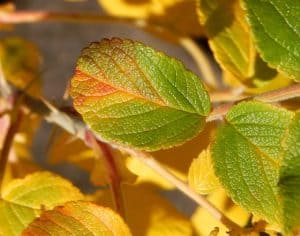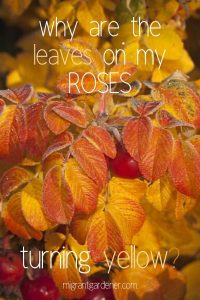Why do the leaves on my roses turn yellow and what can I do about it?
Or the leaves on your roses may be turning yellowy-brown or just brown. In any event, chances are it’s the same issue or issues that are impacting your roses.
It’s not only frustrating to see yellow or brown leaves appearing on your choice roses it can also be worrying. Yellowing leaves on a rose bush can ruin the beauty of the flowers.
There are a handful of reasons why leaves turn yellow on a rose bush.
What causes yellow or brown leaves to appear on a rose?
Before you can apply any form of treatment, it’s necessary to figure out what the problem is.

Too little light
At or near the base of a rose bush because the upper leaves are shading the basal area lower leaves can turn yellow and drop. This is a natural process so there’s nothing to worry about.
Stress from heat
Rose bushes can be stressed by many factors. Among the most common of these is too much heat. In this case, the bush will try to cope with the heat by shedding leaves.
Radiant heat can also cause stress to roses. Here, it’s about the area beneath the bush retaining a lot of heat. This heat radiates upwards. The lower foliage, in particular, starts to yellow and drop.
The ground may become too hot on account of some mulches. Darker-colored mulches, as well as rock-type mulches, may hold onto heat. This then reflects upwards to the rose. To avoid this from occurring, go for a light-colored mulch and spread the mulch right around the base of the plant.
Reflected heat through water
Yes, even water can reflect heat and in turn, this can cause yellowing of the plant’s leaves.
To avoid this, don’t overwater your roses. And make sure that when you do water the water does not sit beneath the bush.
By all means, water your roses well, but no need to drown them.
Stress from cold
Yes, just like any plant, or almost any plant, roses, too, can be stressed by cold – cold temperatures and cold winds. Perhaps the only remedy here is to remove your rose or roses from their current locale and relocate to a more sheltered position in your garden.
Fertilizer
Rose foliage can also be burned when too much foliar feed or granular fertilizer is added.
Deficiencies of certain nutrients can also be to blame. Iron, magnesium, and nitrogen deficiencies can be the cause of yellowing rose bush leaves.
When a deficiency is treated in time, the leaves will regain their lush green coloring.
Over- and under-feeding roses or any type of plant is not so easy to figure out. It may be necessary to test your soil for nutrient content. Just remember, it’s better to underfeed than to overfeed as underfeeding roses is an easier proposition to correct.
Pests and/ or disease
Yellowing leaves on roses can also be caused by pests or diseases. There are many pests and numerous diseases that cause leaves to turn yellow.
How do you determine what the problem is?
Check your rose/s over carefully. Look for any signs of either pests or disease. Then do some research as to how to remedy the problem.
Common pests that cause rose leaves to turn yellow:
Spider mites
Rose leafhoppers
Common diseases that cause rose leaves to turn yellow:
Black spot
Chlorosis
Chlorosis is caused when soil pH is too high. Either that or it’s because the soil lacks sufficient iron content. Either that or it’s because there’s not enough oxygen which means the roses are overwatered or your soil is clogged and not free-draining.
Chlorosis may not cause the entire leaf to yellow. It can also result in the veins on the leaves turning yellow, though the leaves will remain green.
Roses are not fond of water sitting around the root zone. In summer, in most regions, watering roses twice weekly is enough. If it’s down to your soil and a lack of decent drainage you may have to move your roses to another part of the garden that enjoys better drainage.
Underwatering
Oh, yeah, rose leaves turn yellow because of too much water around the root zone. But they can also turn yellow because the plants are not getting enough water. Whoever said that gardening was easy?
To determine if your soil is too dry, stick your finger in and feel around. If you want more accuracy, use a soil moisture meter.
For best watering results, you can use a soaker hose or drip irrigation. This will help to ensure that the roots are getting plenty enough water.
Sprinklers may be adequate but during warmer weather, they do tend to lose water because of evaporation. Plus, overhead watering can lead to water running away from the root zone rather than soaking down into the root zone.
Natural yellowing
There is one other reason why some roses ‘suffer’ from leaf yellowing. It’s natural. And it’s caused on roses such as the rugosa rose species when summer turns to fall. Actually, this is, for obvious reasons, the best type of rose-leaf yellowing – the coloration can be exceptionally beautiful!

